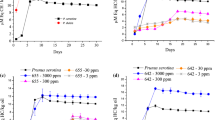Abstract
The oil from the dried seeds of the Moringa oleifera tree (variety of Malawi) was extracted with a mixture of chloroform/methanol (50∶50). The induction period measurements demonstrated a great resistance to oxidative rancidity. After degumming, there was a reduction of 74% in induction periods. The gums produced were extracted with diethylether, n-butanol, and water, yielding four fractions: Fraction 1 (81.8% w/w), Fraction 2 (0.04% w/w), Fraction 3 (0.05% w/w), and Fraction 4 (17.0% w/w). These fractions were tested for their protection of fresh sunflower oil against rancidity, at 50°C, using a UV accelerated method. The oxidation of the sunflower oil was measured using PV; absorbance E 1%1cm and malondialdehyde concentration were measured by HPLC. The fraction that showed the highest antioxidant activity was further fractionated by HPLC, yielding seven fractions. Fraction HPLC 3 (present in a quantity of 330.8 and 29.11 ppm in gums and oil, respectively) showed the highest antioxidant activity. Its activity was also compared with that of the commonly used antioxidants BHT and α-tocopherol on sunflower oil using the same methods. At the same level of addition (200 ppm), HPLC 3 showed higher antioxidant activity than BHT and α-tocopherol. The identification of HPLC3 was done using 1H NMR, 13C NMR, MS, melting point, and UV absorption spectroscopy and proved to be 3,5,7,3′,4′,5′-hexahydroxyflavone (myricetin).
Similar content being viewed by others
References
Dewdney, P.A., and M.L. Meara, Natural Fat-Soluble Antioxidants, Sci. Tech. Surv. 96:1–34 (1977).
Farag, R.S., A.Z.M.A. Badel, F.M. Hewedl, and G.S.A. El-Baroty, Antioxidant Activity of Some Spice Essential Oils on Linoleic Acid Oxidation in Aqueous Media, J. Am. Oil. Chem. Soc. 66:792–799 (1989).
Gopalakrishna, A.G., and J.V. Prabhakar, Antioxidant Efficiency of Water Washed Gums as a Function of Relative Humidity in Peanut Oil, 62:1581–1583 (1985).
Ibrahim, S.S., M. Ismail, G. Samuel, E. Kamel, and T. El Azhari, Benseeds: A Potential Oil Source, Agric. Res. Rev. 52:47–50 (1974).
Eckey, E.W., Rhoeadales, in Vegetable Fats and Oils, Monograph Series No. 123, Reinhold, New York, 1954, pp. 450–451.
Morton, J.F., The Horseradish Tree Moringa pterigosperma (Moringaceae)—A Boon to Arid Lands? Econ. Bot. 45: 318–333 (1991).
Tsaknis, J., S. Lalas, V. Gergis, V. Dourtoglou, and V. Spiliotis, A Total Characterization of Moringa oleifera Malawi Seed Oil, J. Agric. Food. Chem. 47:4495–4499 (1999).
Quinn, L.A., and H.H. Tang, Antioxidant Properties of Phenolic Compounds in Macadamia Nuts, J. Am. Oil Chem. Soc. 73:1585–1588 (1996).
Ganshirt, H. Quantitative Evaluation of Thin-Layer Chromatography, in Thin-Layer Chromatography, A Laboratory Handbook, edited by E. Stahl, Springer-Verlag, Berlin, 1969, pp. 133–155.
Mangold, H.K., Aliphatic Lipids,, edited by E. Stahl, Springer-Verlag, Berlin, 1969, pp. 388–391.
Markham, K.R., Techniques of Flavonoid Identification, Academic Press, London, 1982, pp. 1–49, 72–99.
Morelle, J., Peroxydes, Lipidiques, Radicaux Libres, Vieillissement et Lipoaminoacides, Parf. Cosm. Aromes. 80:91–104. (1988).
Lea C.H., Methods for Determination of Peroxides in Lipids, J. Sci. Food Agric. 3:586–594 (1952).
Standard Methods for the Analysis of Oils, Fats and Derivatives, in International Union of Pure and Applied Chemistry (IUPAC), 7th edn., edited by C. Paquot and A. Hautfenne, Blackwell Scientific Publication, London, 1987, pp. 212–213.
Tsaknis, J., S. Lalas, M. Hole, G. Smith, and V. Tychopoulos, An HPLC Rapid Method of Determining Malonodialdehyde (MDA) for Evaluation of Rancidity in Edible Oils, Analyst 123: 325–327 (1998).
Casteele, K.V., H. Geiger, and C.F. Van Sumere, Separation of Flavonoids by Reversed-Phase High-Performance Liquid Chromatography, J. Chromatogr. 240:81–94 (1982).
El-Ansari, M.A., D. Barron, M.F. Abdalla, N.A.M. Saleh, and J.L. Quere, Flavonoid Constituents of Stachys aegypticaca, Phytochemistry 30:1169–1173 (1991).
Hedin, P.A., and V.A. Phillips, Electron Impact Mass Spectral Analysis of Flavonoids, J. Agric. Food Chem. 40:607–611 (1992).
Kashima, M., G.S. Cha, Y. Isoda, J. Hirano, and T. Miyazawa, The Antioxidant Effect of Phospholipids on Perilla Oil, J. Am. Oil Chem. Soc. 68:119–122 (1991).
Pokorny, J., Stabilization of Fats by Phenolic Antioxidants. Can. Inst. Food Tech. J. 4:68–74 (1971).
Mabry, T.J., K.R. Markham, and M.M.B. Thomas, The Systematic Identification of Flavonoids, Springer-Verlag, New York, 1970, pp. 1–58, 115–120, and 275–295.
Markham, K.R., Isolation Techniques for Flavonoids, in The Flavonoids: Advances in Research, edited by J.B. Harborne, T.J. Mabry, and H. Mabry, Chapman and Hall, London, 1975, pp. 1–44.
Markham, K.R., and V.M. Chari, Carbon-13 NMR Spectroscopy of Flavonoids, in The Flavonoids: Advances in Research, edited by J.B. Harborne and T.J. Mabry, Chapman and Hall, London, 1982, pp. 19–135.
Hudson, B.J.F., and J.I. Lewis, Polyhydroxy Flavonoid Antioxidants for Edible Oils: Structural Criteria for Activity, Food Chem. 10:47–55 (1983).
Pratt, D.E., and B.J.F. Hudson, Natural Antioxidants Not Exploited Commercially, in Food Antioxidants, edited by B.J.F. Hudson, Applied Science, London, 1990, pp. 171–193.
Wanasundara, U.N., and F. Shahidi, Stabilization of Canola Oil with Flavonoids, Food Chem. 50:393–396 (1994).
Sengupta, A., and M.P. Gupta, Studies on Seed Fat Composition of Moringaceae Family, Fette Seifen Anstrichm. 72:6–10 (1970).
Author information
Authors and Affiliations
Corresponding author
About this article
Cite this article
Lalas, S., Tsaknis, J. Extraction and identification of natural antioxidant from the seeds of the Moringa oleifera tree variety of Malawi. J Amer Oil Chem Soc 79, 677–683 (2002). https://doi.org/10.1007/s11746-002-0542-2
Received:
Accepted:
Issue Date:
DOI: https://doi.org/10.1007/s11746-002-0542-2




